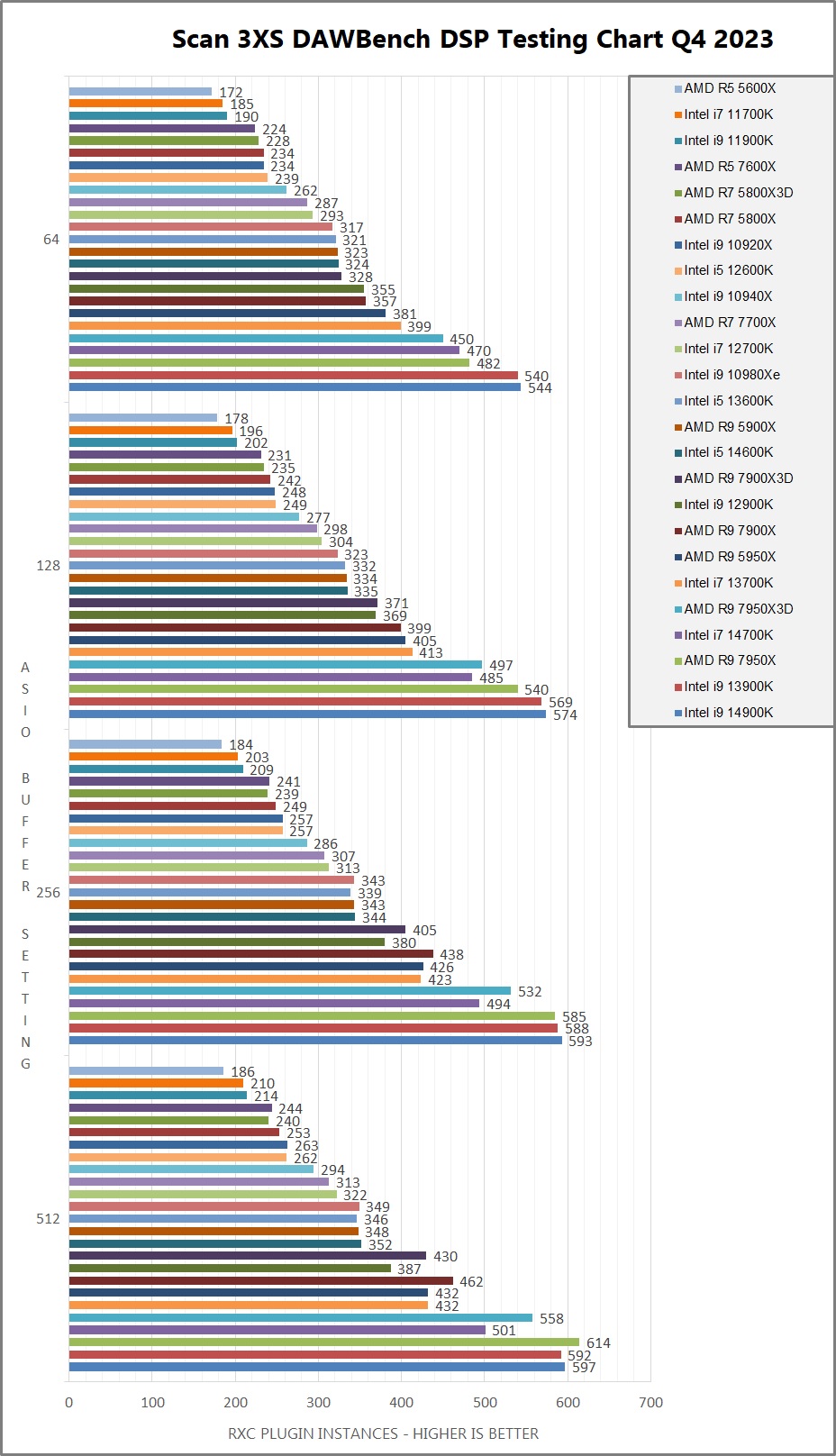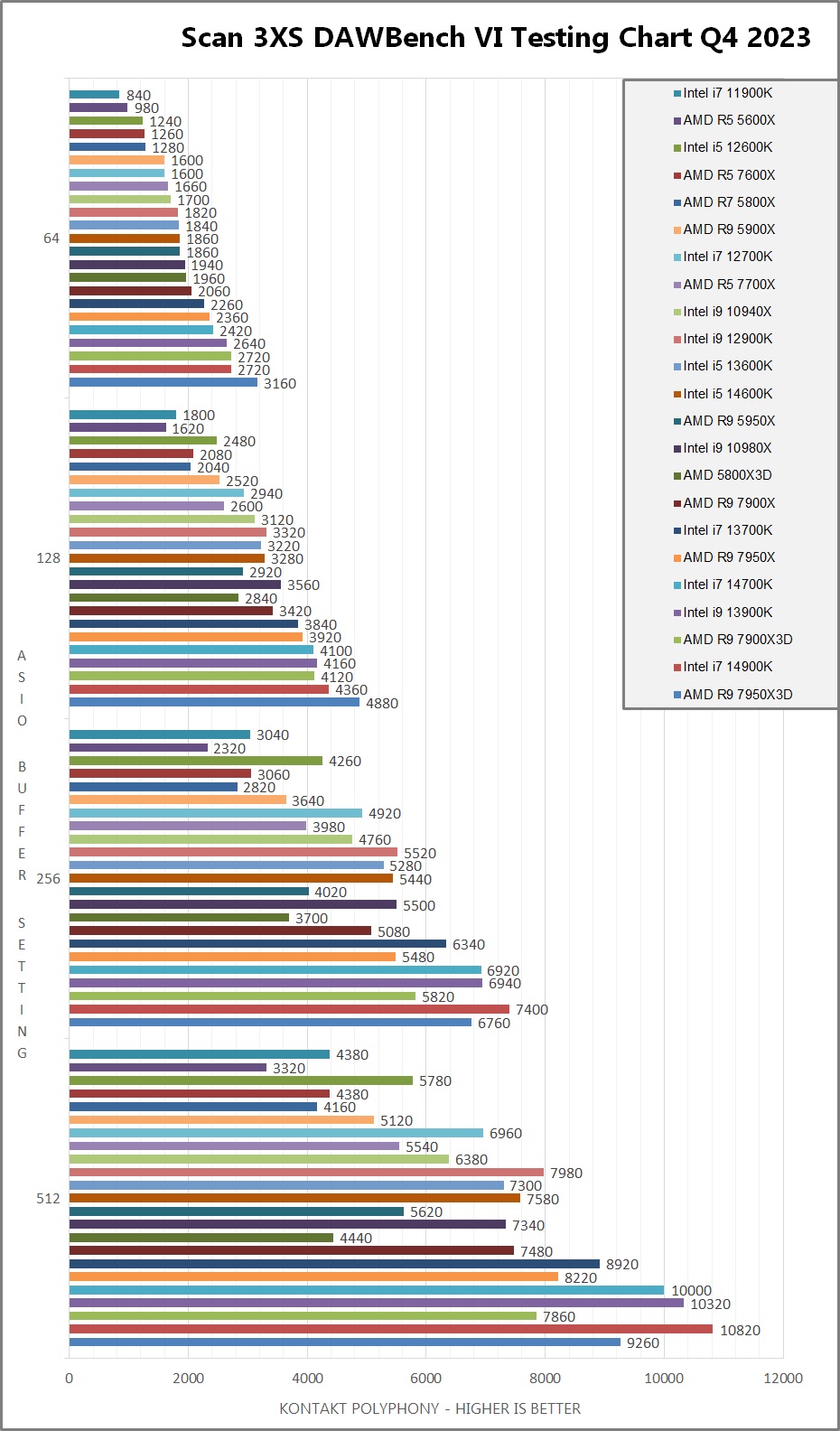Intel 14th Gen – Tested for the studio
Now that 2023 has come to a close, we return for a look over the new CPU offerings 2023 had to offer.
We saw a number of more fringe releases in 2023, with the return of Intel’s high-end Xeon workstation chips along with AMD's 7000 range receiving X3D models and the more highly clocked 13900KS, all of which offered their own pro's and con's, although in terms of audio handling none proved to be truly stand out across the board. Instead, in terms of both performance and value the Intel 13900K and AMD 7950X mid-range flagships have continued throughout the year to offer the most well-rounded solutions for many users in the studio.
Here today we take a look over the 14th Gen Intel range, as we see the third and final iteration of chips to arrive on Intel’s LGA1700 socket-based boards. This is presented as the "Raptor Lake" refresh, which sees the platform remaining on the existing "Intel 7" production process that is based upon the existing 10nm node design seen over the last couple of generations. Effectively one final hurrah for the platform before we see future offerings move to the newer “Intel 4” process which will be based around a 7nm node design.
Working with a well-established platform means that there will be some general improvements to the silicon, often to be found due to the platform maturing and refinements to a chip's production over its lifetime, where historically for example we'd often see later revisions of a given chip that would prove to be the golden choice when it came to overclocking. This already proved to be the case with the 13900KS earlier in the year, where Intel took the best batches of its 13900K silicon and applied a further boost of 200MHz to the turbo rating offering an increase in performance for gamers or users of applications utilizing smaller core counts.
For audio handling in contrast we look for the best average all core speed, rather than a few isolated cores with improved performance. The KS edition whilst it gained on a sub-section of cores, it's all core average turbo rating remained in-line with the original 13900K, resulting in little extra performance in the studio with the newer chip. By contrast the 14900K update manages to add a few extra hundred MHz to the all core ratings on top of the performance offered by the prior 13th generation, which should help to offer some gains overall.
Alongside this a number of Intel overclocking presentations have noted improved RAM XMP support up to a 8000MHz, although officially the chips haven't raised the supported figure above the same 5600MHz rating found with the 13th gen chips, potentially missing out on what could have been an easy performance gain by not raising the official recommendation. We've seen in prior testing that an increase in RAM speed can have positive outcomes when it comes to handling sample libraries and we've seen continued improvement both with performance and compatibility over this platform’s life cycle, crucially with support being boosted to a potential 192GB of RAM in many setups.
The test bench configuration consists of an Asus Z790-A Prime running the latest BIOS to add 14th Gen support, along with 64GB of Corsair Vengeance 5600MHz RAM and cooling provided by a be quiet! Silent Loop 360 AIO.


Looking across these new models with only small increases to the core clock ratings, the improvements seen in the DSP test on both the 14600K and 14900K appear relatively muted with improvements of just a few percent. The exception here comes in the form of the 14700K which whilst receiving the same clock bump as the other models in the range, also receives 4 additional "Efficiency" cores to help spread the workload further.
Performance gains on the VI test by contrast are slightly more notable across the models, although with small improvements to the IMC (memory controller) being noted and DDR5 as a platform having continued to mature over the past year, this could also be adding to the modest gains shown here.
Of the three chips the 13600K even under maximum load remains well below 250W's making it relatively easy to cool by either air or water-based solutions. The 14700K if left to run at its optimum can peak around 20w - 30w's higher than the rated 253W's TDP figure under turbo burst scenarios, although even with the additional cores this remains within a few percent of the older 13700K's average real world TDP handling. The official TDP rating these days is now treated more of an advised average under load with chips permitted to boost beyond this figure when required. At the top of the range the 14900K much like the 13900KS before it, takes full advantage of this when applying its turbo clock. When left with the boards commonly unrestricted defaults it’s not unusual to find that
without restrictions on power delivery the chip can easily enter the 300W – 350W range, a power draw which can challenge even the best high performance coolers available.
Upon initial testing one thing quickly stood out, in that the changes to the current generation required increased load line support, supplying more voltage through the VRM's and into the CPU. Both the 14600K and 14700K handled well on more relaxed settings in comparison to the 14900K which along with the other package changes makes it a more power demanding chip than its predecessor overall and requiring suitable cooling to match. Modern chips are rated up to a given turbo rating, which they will attempt to boost to before settling at a potentially lower speed over the longer term. We have to account for both the VRM's delivering power and the CPU itself when it comes to ensuring stability here which means not only cooling the CPU but the area surrounding the socket.
The be quiet! Silent Loop 360 is an efficient and well rated cooler, which still achieves a relatively low noise output in its segment. Whilst effective on the CPU itself, there's a reliance with any water cooler on a strong airflow to cool the crucial components around the socket itself. This is naturally occurring with an air cooler, but often requires the careful choice of high air flow fans to ensure we get the best from the setup. A lot of the default profiles supplied with the mainboards available have a fully unrestricted power draw available to boost CPU performance in a bid to extract the most from each chip, but this can come at the cost of sizable swings in overall power draw. In contrast we have been working more in-line with the chip makers recommendations over the
past few generations to ensure we get the advised performance supported with a more balanced power profile its terms of cooling to ensure suitability in the studio. Taking it back to the motherboard supplied profiles over the Intel recommendations, with enough additional cooling there may prove to be some overhead still to be had, but with the need to fit a gamer grade cooling setup with a larger number of additional fans to maximise the overall air flow. The increase in consumed power at all stages of driving the processor has the potential here to be limiting the average performance at the very top end currently, through the power requirements when sustaining longer periods of heavy usage, as the headline turbo ratings are more typically seen in quick burst situations. We've seen
in the past that often with subsequent BIOS releases after a chip launch, the may be a focus on refining the power delivery across the chipset. Potentially we could still see some small refinements to how these handle in later BIOS revisions, although with this being such a mature platform it'll be interesting to see if they can still tweak it further.
This ultimately is being billed as one final refresh ahead of the changes coming with the 15th generation chips. For anyone looking at a new system right now, it’s a welcome small boost to performance at each level on an already well-established platform. Whilst there is little here to tempt owners of an 13th generation Intel setup, the gains seen over the 12th generation chips which run on the same socket as the 14th gen, might be enough to sway a few users to take an easy upgrade path before the new platform arrives in 2024.
Importantly for Intel it places them in a slightly stronger position ahead of AMD’s Ryzen 8000 launch due in 2024 when looking at raw performance. However, AMD's continued focus on achieving high-performance on relatively low powered chips continues to ensure both brands have their own individual strengths to consider. With Intel's own 15th gen process shrink on the cards for later next year, it's quite possible that 2024 will offer us more excitement as with the current results both firms have everything to play for.
Scan Fixed Series Audio Systems >